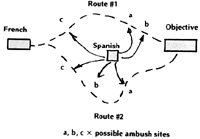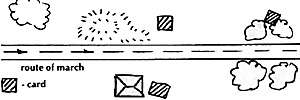Surprise attacks are the most difficult of all tactics to perform on the wargames table in a Solo situation. No matter how hard one might try to pretend that they do not know where the enemy is lurking in ambush, you can never pull it off satisfactorily. There is the choice of either sending your favourite battalion to a certain death at the hands of a motley crew of barbaric guerrillas who everyone knows are there but must march on regardless pretending that they are not, or you may choose the other published method of running from one side of the room to the other, making your moves on a map and hoping that you will forget who is where in the time taken to move from one side of the room to the other.
Though the latter may sound a bit ridiculous it does have some merit in a strategic solo campaign if only straight forward moves are made. As soon as you pause to work out a sneaky flank attack, or send your cavalry on a ride around the enemy by devious routes, it becomes more and more difficult to forget what you have so labouriously planned.
How then can a satisfactory ambush be laid and sprung without doing away with the element of surprise. First, take a look at the mechanics of the thing. An ambush, by definition, is a surprise attack from a concealed position. In a dual game this situation is very simple to bring about using standard concealment rules.
The solo gamer, on the other hand is faced with a very difficult situation unless he is fortunate enough to have a friend or family member willing to indulge his whims long enough to take the time to play the part of the enemy in setting up and springing the trap. If not, the solo gamer must rely on his own impartiality to bring the ambush to a successful conclusion. Either that or forget the whole thing and go back to out in the open battles.
One of the beauties of solo gaming is that it permits endless experimentation with ideas, tactics and rules. If you try something and it doesn't work then nothing is the worse for it. There is no grumbling from defeated opponents about 'stupid rules' or 'dumb ideas.' You simply write it off to experience and try something else. Solo gaming provides an endless challenge and to a gamer with a little imagination it can never become boring.
In addition to my other campaigns I have a Colonial affair underway in which the three major powers of Caledonia, Morgania and Albiona are vying for control of newly discovered Novaterra. The later is populated primarily by an American Indian type of people who have taken strong exception to the outside incursions. Armed primarily with bows and spears, these natives would have little chance against a couple of regiments of the line armed with muskets if placed on the table in a one to one situation.
Balance
Therefore, in order to create a more balanced situation I devised a set of rules to give the Novaterrans a fighting chance. These rules can be used for any period from Ancient to Modern. For example, Celts can ambush Romans in the forests of Gaul; Spanish guerrillas against Napoleon's finest in the Peninsula; French resistance against a German convoy in occupied France; or Confederate raiders against Union supply trains in the deep South. The possibilities are endless. Regardless of your era, factual or fictional, these rules are applicable.
In the initial development of these rules I experimented with a number of methods. Perhaps the most difficult to reconcile was the ambush as part of a campaign. Let us say, for example, that there are three regiments of French light infantry on their way to reinforce your main force during the Peninsula War. The British are in a resonably strong position and on the defensive but are already outnumbered by the French. Should the three light infantry regiments join with the main body, the British position could be easily overrun.
Therefore, as commander of the British force you decide to attempt to stop or at least slow down the French lights in order to give yourself time to reinforce the British. The only expendable force available to you is a motley band of Spanish guerrillas at about half the strength of the lights. In an open battle they would have little chance of stopping the French if an ambush could be arranged their chances would increase considerably.
Now comes the problem. How do you set up an ambush so that the French and Spanish forces meet without favouring the movements of one of the forces. Remember you are in command of the French force as well as the British force and as such must be hostile, friendly and impartial to both.
How?
My method, which has been quite successful, is similar to that outlined in my previous article on SOLO CAMPAIGN MOBILIZATION RULES in THE COURIER 11-1. Firstly, I study the strategic map and decide upon 2 routes which the French might take to reach their objective. Now, based on the fact that the ambushers would probably be familiar with the terrain and be able to make a resonably accurate guess as to the most likely route for the French to take, I then write up orders for the guerrillas to proceed to one of two separate places along the two routes of march and one place not on the route. Thus a map might look like this:
 Once this has been done, roll a die to determine
which of the two routes the French will take: odd = route
#1; even = route #2.
Once this has been done, roll a die to determine
which of the two routes the French will take: odd = route
#1; even = route #2.
This decided roll two dice of different colours for the ambushers: red = route #1; green = route #2. Then take the highest of the two dice and roll it again to determine where on the designated route the ambush takes place: 1-2 = position a; 3-4 = position b; 5-6 = position c.
Should the ambush position be on the wrong route you have two options. 1) Tough bananas, guys, you blew it; or 2) the ambushers (after a certain period of time) can move to attempt to intercept the column on the other route. The second half of the die roll system above can be used in an attempt to accomplish the ambush.
All's Well
Let us assume that all went well with the first roll. The French column is on its way and the guerrilla ambush has been laid. When the French reach the contact point a new problem arises. How do you conceal the ambushers on the tactical table?
Hopefully, there will be a number of areas on the table wherein ambushers can skulk. Cover such as forests, hills, buildings are always helpful in setting up an ambush. It is imperative that at least two such areas exist for if they do not there is little likelihood that an ambush would have been laid there in the first place. Their heads may be made of metal or plastic but they are not that stupid.
The first thing to do is to map out the route of march I to be taken by the unsuspecting ambushees. If they have been following a road up to this point there is no reason to suspect that they might suddenly do otherwise. If travelling cross country then they would more than likely take the shortest and easiest route across the table.
 Now that the route of march has been mapped out
check your tactical table or map for any and all possible
ambush points within a charge move of the route of march.
If few or none are available, make some. A pile of dead
trees at the roadside or an innocent looking rock wall
recently placed by the guerrillas can provide the ambush
point you require.
Now that the route of march has been mapped out
check your tactical table or map for any and all possible
ambush points within a charge move of the route of march.
If few or none are available, make some. A pile of dead
trees at the roadside or an innocent looking rock wall
recently placed by the guerrillas can provide the ambush
point you require.
Take a standard deck of playing cards or draw up your own if none are available and select one card for each possible ambush position with one card being different from the others. For example, if four possible ambush positions are available, pick out three red and one black cards. Now shuffle and place the cards face down on the table so that you do not know which is which. Each card designated to a specific ambush spot. (See Map.)
Place the French on the table and begin moving at a standard movement pace (or forced march if that is how they have been moving on the strategic map). When they are within medium range of a possible ambush site turn over the card. If it is the odd card (black in the example) then the Spanish are there. Surprise! Surprise! If not, continue the march to the next card and repeat the procedure.
Once the trap has been sprung, roll a die to determine if the enemy fires or attacks at medium range (1-2-3) or short range (4-5-6). The first volley fired should not be simultaneous. In effect the element of surprise is taken into account by giving the ambushers a free nonreturnable volley. French casualties are removed immediately. The ambushers may be placed in position at the players discretion or if you don't trust your own impartiality, dice for position. From then on the battle continues as would a normal battle with the ambushers having all the benefits of cover where applicable.
If the line of march takes the French out of range before firing begins then the ambushers may charge according to die roll.
This system can be used in the same manner for dual action games or non-campaign battles. For the latter, the more ambush sites the better. Regardless of your preferences, give it a try, if nothing else it makes for an exciting evening's battle.
Back to Table of Contents -- Courier Vol. 2 #3
To Courier List of Issues
To MagWeb Master Magazine List
© Copyright 1980 by The Courier Publishing Company.
This article appears in MagWeb (Magazine Web) on the Internet World Wide Web.
Other military history articles and gaming articles are available at http://www.magweb.com